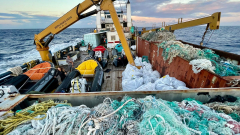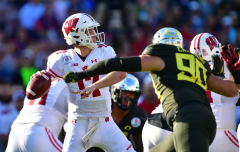With an estimated 115,000 pounds of debris accumulating on the reefs of Papahānaumokuākea, crews are struggling against a pileup that keeps building.

One month in, the trash plucked from the ocean had piled up – sopping fishing nets covered in plastic that had choked Hawaii’s coral reefs. The cleanup crews knew their task was far from over.
“It’s a lot of work, a lot of long days,” said Kevin O’Brien, founder of the Papahanaumokuakea Marine Debris Project. “But we do it because we’re trying to protect a place we love.”
When they finished last week, three shipping containers were heaped with debris fished from the waters of Papahanaumokuakea Marine National Monument, a hub for biodiversity and home to sacred cultural and historical sites. In total, 97,295 pounds, or about 48.6 tons, of marine debris were removed, about 86,000 of which came from a single reef.
“That’s equal to about the weight of a commercial commuter airliner,” O’Brien said.
Despite their efforts, O’Brien said, there is a “humongous backlog of accumulated debris from the last 10 to 15 years” as the plastics continue to build. The team plans to set sail again in September with the goal of catching up with the backlog and keeping up with annual accumulation.
Megan Lamson, a program director at the Hawaii Wildlife Fund, called this expedition’s haul “a hugely significant” achievement.
But about 115,000 pounds of marine debris accumulate on the reefs of Papahanaumokuakea each year, according to PMDP, so crews are struggling against a pileup that keeps building.
“The debris just keeps accumulating and accumulating,” said Mark Hixon, marine biology professor at the University of Hawaii at Manoa and a member of the Papahanaumokuakea reserve advisory council. “It’s fighting the onslaught.”
‘CLEANING UP THIS THREAT’: Team hauls more than 47 tons of marine debris out of Pacific Ocean
What is Papahanaumokuakea?
Papahanaumokuakea Marine National Monument is a string of remote, uninhabited islands making up the last 1,300 miles of the Hawaiian island chain, O’Brien said. Named a natural and cultural World Heritage Site by the United Nations Educational, Scientific and Cultural Organization, it’s the largest contiguous, fully protected conservation area in the USA, covering an area larger than all of the country’s national parks combined.
Papahanaumokuakea contains 3.5 million acres of coral reef, about 70% of all the coral reef in the USA., O’Brien said. The reefs are home to a vibrant ecosystem of more than 7,000 marine species, 23 of which are endangered and about a quarter of which are found nowhere else but Hawaii. Hawaii’s endangered monk seals, endangered Laysan ducks, threatened green turtles and thousands more species live there, despite the plastic that has encroached on their habitat.
“It is remarkably special,” Hixon said. “It’s a biodiversity treasure trove.”
With multiple sacred sites on its islands, Papahanaumokuakea has “extreme cultural and religious importance to the native Hawaiian community,” Hixon said.
“Papahanaumokuakea is considered a sacred area, from which Native Hawaiians believe all life springs, and to which spirits return to after death,” the monument’s website said.
‘FLOATING PLASTIC HABITAT’: A giant patch of garbage in the ocean is home to a thriving new community
Why debris accumulates
The Great Pacific Garbage Patch, one of at least five patches of trash in the world’s oceans, formed as ocean currents swirl in a vortex, pulling microplastics and larger debris together. Lamson said some debris “leaks” from garbage patches into Papahanaumokuakea, where the islands and shallow reefs gather debris like a comb.
“Our islands and reefs act almost like a sieve and capture the debris,” Lamson said.
SEA LEVEL RISE, HIGH TIDE FLOODING: Feds warn water levels are ‘nearing the brim’
Damage ‘like nothing I’ve ever seen’
The debris threatens sea life. Creatures may ingest plastics or get caught in or injured by them, Lamson said. Invasive species may hitch a ride on floating trash. The debris may change the chemistry of the ocean, decreasing the amount of oxygen available to sea life. When plastics break down further, microplastics can pose problems, including for humans, she said.
Discarded fishing nets, called ghost nets, can snag on coral and destroy colonies when wind or waves rip them free, Lamson said. Or they can grow algae and smother the coral, leaving it to die underneath. Marine critters can get tangled in the nets.
“They are essentially floating killing machines,” Lamson said.
IS THE GLOBE PREPARED? Extreme heat waves may become regular
O’Brien, who first visited Papahanaumokuakea in 2007, said he remembers the shock of seeing an idyllic, white sand beach and crystal blue water – all littered w





